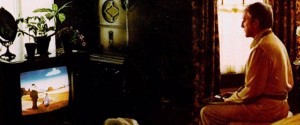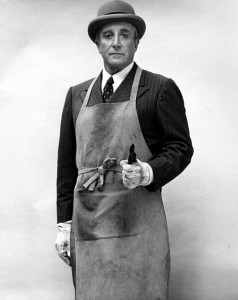100 Film Favorites – #96: Being There
(Hal Ashby, 1979)
Adapted from a novel by Polish writer Jerzy Kosinski, Being There chronicles the misadventures of Chance (Peter Sellers, in his last film released during his lifetime). Chance is a simple-minded man who has spent his life tending the garden of an elderly, well-off gentleman in exchange for a place to live. Aside from gardening, Chance’s main hobby is watching television, a past-time through which he gains most of his knowledge of the outside world. One day, the old man dies, and Chance is forced to leave his home. Dressed in his benefactor’s vintage suit, Chance wanders the city, baffled and bemused by the world he’s seeing essentially for the first time. As he stops in the street to stare at a TV store window display, Chance is struck by the automobile of Ben Rand, a multi-millionaire known for his many political connections. Fearing legal prosecution, Rand takes Chance in at his palatial mansion (filmed at the Biltmore Estate in Asheville, North Carolina). In their first encounter, Ben mistakenly hears Chance introducing himself not as “Chance the Gardener,” but as “Chauncey Gardiner.”
During his time with Ben, Chance “chances” into numerous encounters with various political figures. These figures are invariably charmed by “Chauncey’s” timeless dress, terse remarks, and “simple wisdom,” remaining oblivious to his intellectual defects. Chance’s anecdotes about gardening are interpreted as insightful observations on how to “grow” a strong economy, and soon “Chauncey Gardiner” is a renowned political analyst being quoted throughout the media. Chance’s growing influence leads to him becoming an informal adviser to the President himself, before the President comes to view this apparent political genius with massive popular appeal as a competitor for his job. All the while, Chance remains oblivious that anything is out of the ordinary, and continues his simple life of parroting TV soundbytes and muttering garden-themed asides.
The film ends at Ben’s funeral. As they walk the casket toward his tomb, Ben’s pallbearers confer over whom to support as the next candidate for president. During the ceremony, Chance wanders off into the woods on the estate grounds. Just as the pallbearers reach the tomb, they agree unanimously to nominate “Chauncey Gardiner” as their party’s candidate for the presidency. At this moment, off in the woods, Chance strides out across a lake, apparently walking on its surface.

The story of a mentally disabled person rising to greatness by stumbling into one coincidence after another is very similar to the plotline of Forrest Gump, which was released 15 years after Being There and which, as you may or may not have guessed, is destined to also appear later in this countdown. Being There, however, addresses the idea much more sardonically than in Gump. The implication here seems to be that people are so desperate for a savior to solve their problems they will make a Chauncey Gardiner out of any idiot who chances to come along. (This is in line with my interpretation of the ending scene: Chance may well be standing on a submerged dock or other platform, but regardless of what’s really going on, we now see him as the other characters do – Christ-like, a potential savior). Alternatively, the message could be that our culture’s reliance on superficial details like dress, quotable soundbytes, and TV appearances warps our ability to truly know or understand the character of our leaders. It’s a grim possibility that’s only grown more poignant over the last three decades as our culture grows more hyper-saturated with media.
These sinister undertones, however, never fully overpower the film’s comedy. The idea of an oblivious populace idolizing a simple man who is simultaneously oblivious of being idolized makes for a very funny premise. In fact, one of Being There‘s most prominent legacies is as the partial basis of a string of Arrested Development episodes featuring Michael’s girlfriend Rita Leeds, a British woman whom the Bluth family believe may be a cunning spy, before realizing she is actually retarded. Rita’s final appearance is in the episode “The Ocean Walker,” which ends with her breaking up with Michael before ultimately striding off across the surface of the Bluth family pool (rigged by GOB with clear platforms for an illusion). The noble tradition of Chauncey Gardiner endures.
 Be back tomorrow for #95!
Be back tomorrow for #95!
—
Brian Terrill is the host of television show Count Gauntly’s Horrors from the Public Domain. You can keep up with Brian’s 100 Film Favorites countdown here.






